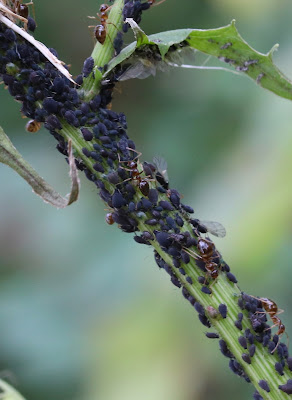Nature in October:
I continue to be in awe of the relationship between ants and aphids. I found this group in Canatara and was surprised that they were all able to move in the cold weather that we experienced earlier in the week. The aphids produce honeydew which the ants eat. In exchange for this food, the ants protect the aphids from predators!
An Eastern Towhee quietly hung out in a tangle of sticks and vines. They spend most of their time on the ground, scratching at leaves, using both feet at the same time in a kind of backwards hop. They are a short-distance migrant. Towhees that spend the summer north of Virginia and southern Indiana move south during the winter, but Towhees south of that line may not migrate at all if they have a food source.
https://www.allaboutbirds.org/guide/Eastern_Towhee/id
White-throated Sparrows also forage for food at ground level. They will readily visit feeders or peck at fallen seeds beneath them. If you make a brush pile in your yard, it will give them a place to take cover in between trips to the feeder.
https://www.allaboutbirds.org/guide/White-throated_Sparrow/overview
Even though Carolina Wrens have very loud vocalizations, my eyes often struggle to locate the singing birds. This morning I found the wren hiding in a tangle of vines. Carolina Wrens defend their territories with constant singing. They will aggressively scold intruders away. Perhaps it perceived me as the intruder!
https://www.allaboutbirds.org/guide/Carolina_Wren/id
https://www.allaboutbirds.org/guide/Carolina_Wren/id
Rainbow over Lake Huron earlier this month.






No comments:
Post a Comment